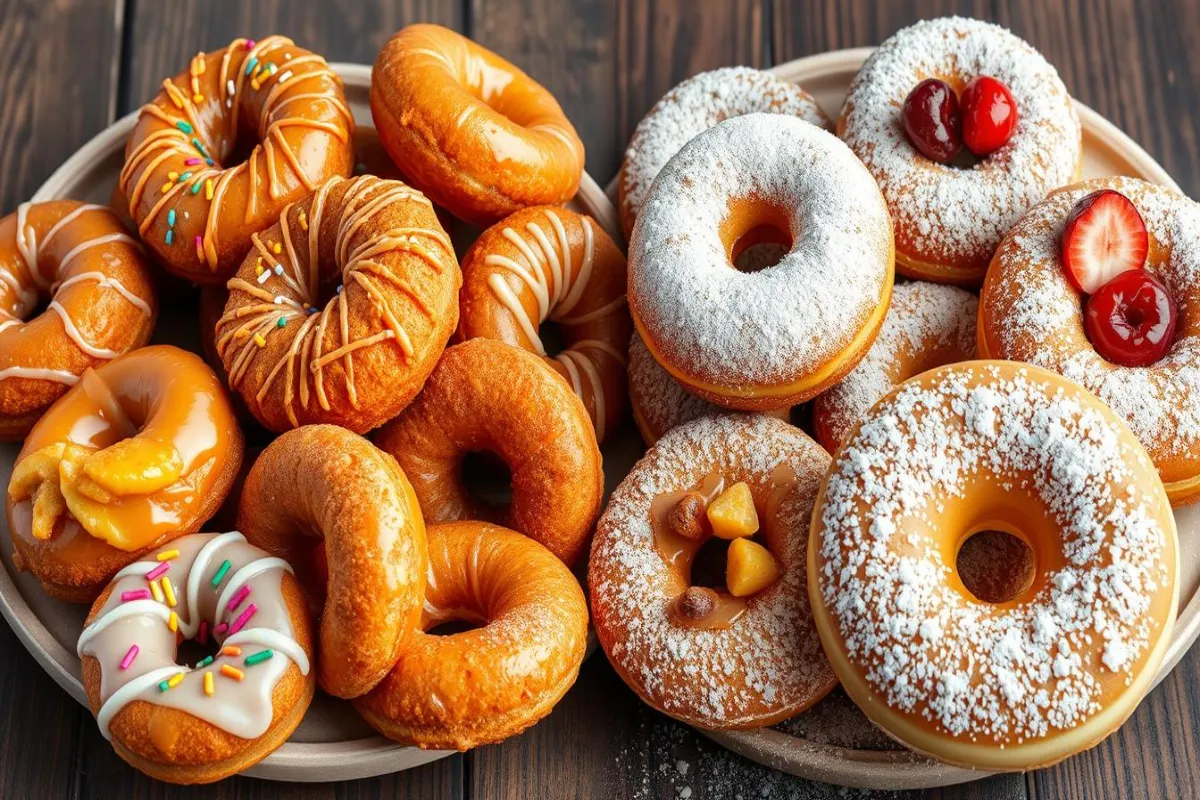Doughnuts have a special place in our hearts. Fried vs baked doughnuts is a debate that has captivated dessert lovers for years. Whether we enjoy a classic glazed treat on a Sunday morning or indulge in a decadent filled doughnut, there’s no denying their appeal. But when it comes to fried versus baked doughnuts, the debate continues: which is better? In this article, we’ll dive into every aspect of both fried and baked doughnuts to help you decide which is the ultimate treat for you.
History of Doughnuts
The origin of doughnuts is as rich as the treat itself. Fried doughnuts trace their roots back to ancient Egypt, where early versions, like “lokma,” involved deep-frying and drizzling with honey. Later, the Dutch introduced a baked version called “olykoek,” a cake-like doughnut made with yeast, which laid the foundation for the modern baked doughnut.
The popularity of doughnuts spread across cultures, with each region adding its own unique twist. In the United States, doughnuts gained popularity during the 19th century, thanks to the Dutch settlers. By the early 20th century, doughnuts became a staple in American bakeries, and innovations like the automated dounut machine made fried doughnuts more accessible. Today, fried doughnuts are more synonymous with brands like Krispy Kreme, while baked versions have become popular for those looking for a healthier alternative. If you’re considering baking your own doughnuts, check out these tips on reducing fats in baking from the American Heart Association for healthier options.
The Science Behind Frying and Baking Doughnuts
The process of making fried doughnuts involves submerging dough in hot oil. This causes the water content in the dough to evaporate, producing steam, which in turn makes the dough expand and become fluffy. The hot oil reacts with the dough’s surface, leading to a Maillard reaction, which creates that irresistible, crispy exterior and caramelized flavor that is difficult to replicate by baking. Frying gives doughnuts their characteristic texture—crisp on the outside and tender on the inside. However, frying also increases fat content, which is important to consider when making dietary choices.
The Maillard reaction occurs when amino acids and reducing sugars react under high heat. This reaction enhances flavor and gives fried doughnuts their golden-brown color and distinctive aroma. The combination of the crispy crust and fluffy interior makes fried doughnuts so appealing. However, it’s important to keep in mind that frying also leads to a higher calorie count due to oil absorption, making fried doughnuts a more indulgent choice.
In contrast, baking doughnuts involves cooking them in an oven. Because baking doesn’t involve oil, baked doughnuts generally contain fewer calories and less fat compared to fried ones. However, they also tend to be denser, with a cake-like texture instead of the light, airy texture found in fried doughnuts. To make baked doughnuts more flavorful, consider using healthier ingredient substitutions, as highlighted in this guide on the health impacts of oils from the Harvard T.H. Chan School of Public Health.
Flavor Profiles
Fried Doughnuts
Fried doughnuts have a more intense, caramelized flavor due to the frying process, which creates a rich and slightly crispy exterior. The presence of oil allows the doughnuts to cook quickly, providing an airy, almost melt-in-your-mouth texture. Popular fried varieties include:
- Glazed Doughnuts: The classic, sweet, and golden-brown exterior.
- Jelly-Filled Doughnuts: A fried doughnut filled with fruit preserves or custard.
- Boston Cream Doughnuts: Featuring a custard filling and a chocolate glaze.
- Apple Fritters: deep-fried and filled with apple chunks, often topped with a sugar glaze.
The rich, crispy exterior of fried doughnuts appeals to those who love indulgent treats. The caramelization that occurs during frying adds depth to the flavor, making fried doughnuts stand out.
Baked Doughnuts
Baked doughnuts, on the other hand, have a tender, cakelike texture. They offer a more subtle flavor that can be easily enhanced with different glazes, toppings, and add-ins like fruit or nuts. Popular baked varieties include:
- Cinnamon Sugar Baked Doughnuts: Coated in cinnamon sugar after baking.
- Blueberry Baked Doughnuts: Made with real blueberries for extra flavor.
- Lemon Poppy Seed Doughnuts: Light, fluffy, and tangy.
- Chocolate Chip Baked Doughnuts: Sweet and studded with chocolate chips for added decadence.
Baked cookies are versatile and can be customized with a wide variety of flavors and ingredients. Their denser texture makes them ideal for pairing with lighter glazes and toppings that don’t overpower their subtle taste.

Health Considerations
When comparing the healthiness of fried and baked doughnuts, baked versions have the edge. Baked cookies are generally
- Lower in Calories and Fat: The lack of frying significantly reduces the overall fat content and calorie count, making them a more waistline-friendly option.
- Healthier Ingredients: Baked doughnuts often use ingredients like whole wheat flour, reduced sugar, and healthier oils.
- Less Cholesterol: Baked doughnuts contain less cholesterol since they don’t absorb cooking oil.
On the other hand, fried doughnuts tend to have more:
- Calories and cholesterol: Due to oil absorption, fried doughnuts contain more calories and fats.
- Indulgent Flavor: The oil used in frying provides a unique flavor and contributes to a higher fat content.
- Short-Term Energy Boost: The higher fat and sugar content in fried doughnuts provides a quick energy boost, though it may be followed by a crash.
For those interested in making healthier choices without sacrificing the love for doughnuts, baked doughnuts are the better option, especially for those watching their weight or cholesterol. However, fried doughnuts are an excellent treat for those looking to indulge occasionally.
Cooking Techniques: How to Make Fried vs. Baked Doughnuts
Mastering Fried Doughnuts
When frying doughnuts, it is essential to maintain a consistent temperature of around 350°F. If the oil is too hot, the doughnut’s outside will burn while the inside remains undercooked. If the oil is too cool, the doughnut will absorb too much oil, becoming greasy. For optimal results:
- Use an Oil with a High Smoke Point: Vegetable, canola, or peanut oil works well for frying doughnuts.
- Monitor the temperature closely: Using a deep-fry thermometer helps keep the oil at the right temperature.
- Avoid Overcrowding the Pan: Fry doughnuts in small batches to ensure the oil temperature remains consistent and each doughnut cooks evenly.
- Drain Properly: After frying, place doughnuts on a wire rack with paper towels underneath to drain excess oil and keep them crispy.
How to Make Perfect Baked Doughnuts
Baked doughnuts require the use of a doughnut pan. Since baking relies heavily on maintaining structure through molds, the right equipment is essential.
- Preheat the Oven properly. Bake doughnuts at 350°F for best results.
- Use Healthier Ingredients: Substitute refined flour for whole wheat and reduce sugar for a healthier version. Coat the doughnut pan with non-stick spray to prevent sticking.
- Don’t Overmix the Batter: Overmixing can lead to tough, dense doughnuts. Mix just until the ingredients are combined.
- Add Moisture: Adding ingredients like yogurt or applesauce helps baked doughnuts stay moist and tender.
Texture and Appearance
The difference in texture between fried and baked doughnuts is noticeable.
- Fried Doughnuts: Crisp, golden-brown exterior with an airy, fluffy interior. The crispy exterior gives way to a soft, light center, making fried doughnuts a delightful indulgence.
- Baked Doughnuts: Denser, cake-like texture with a more uniform shape. The texture is closer to a muffin or cupcake, which makes baked doughnuts perfect for those who enjoy a less airy consistency.
Baked doughnuts hold their shape more precisely, making them ideal for intricate designs. Fried doughnuts, meanwhile, puff up unpredictably, adding character to each piece. The unpredictable puffiness of fried doughnuts makes them unique, while baked doughnuts offer a more consistent, aesthetically pleasing look.
Shelf Life and Storage Considerations
Baked doughnuts generally have a longer shelf life compared to fried ones. Fried doughnuts, especially those with glazes or fillings, tend to become stale or soggy faster due to the oil content.
- Baked Doughnuts: Can last up to two days at room temperature when stored in an airtight container. They can also be refrigerated or frozen for longer storage without losing much quality.
- Fried Doughnuts: Typically last around one day before losing their freshness but can be extended to two days with proper storage. Fried doughnuts should be stored in a cool, dry place, but their quality diminishes more quickly due to the oil content.
For longer storage, both types of doughnuts can be frozen, but it’s essential to wrap them tightly in plastic wrap or place them in an airtight container to prevent freezer burn. When reheating, using an oven instead of a microwave helps retain their texture.
Popular Doughnut Varieties
Both baked and fried doughnuts have unique flavors and offer a variety of options to cater to different taste preferences. Some of the most popular doughnuts include:
- Fried Doughnuts: Classic Glazed, Boston Cream, Jelly-Filled, Apple Fritters, and Chocolate Glazed. Fried doughnuts are particularly popular during holidays and festivals when indulgent treats are sought after.
- Baked Doughnuts: Cinnamon Sugar, Lemon Poppy Seed, Blueberry, Chocolate Chip, and Pumpkin Spice. Baked doughnuts are often enjoyed as a lighter alternative, perfect for breakfast or as a midday snack.
Frequently Asked Questions: Fried Vs. Baked Doughnuts
- Which Type of Doughnut is Healthier?
- Baked doughnuts are generally healthier as they contain fewer calories, fat, and cholesterol compared to fried doughnuts. They also often use healthier ingredients, such as whole wheat flour. Baked doughnuts are a great option for those who want a treat without guilt.
- Do Fried Doughnuts Have More Flavor?
- Fried doughnuts tend to have a richer flavor due to the Maillard reaction and oil absorption during frying, which creates a crispy exterior. The flavor is enhanced by the frying process, making fried doughnuts a popular choice for those seeking a more indulgent experience.
- Can Doughnuts Be Both Baked and Fried?
- Yes, some types of doughnuts, such as cake doughnuts, can be prepared using either method. Each method produces a slightly different flavor and texture. Fried cake doughnuts are lighter, while baked cake doughnuts are denser and more cake-like.
- What is the Environmental Impact of Frying vs. Baking Doughnuts?
- Baking doughnuts requires an oven (electric or gas), while frying uses oil, which may be less environmentally friendly. Frying also produces oil waste, which must be properly disposed of. Additionally, ovens can be more energy-efficient, depending on the type of fuel used and the duration of baking.
Conclusion: Which is Better—Fried or Baked Doughnuts?
The debate between fried and baked doughnuts ultimately comes down to personal preference. If you’re looking for a healthier, less indulgent treat, baked doughnuts are a great option. They are lower in calories and can be made with healthier ingredients while offering a cake-like texture. On the other hand, if you crave a decadent treat with a crispy exterior and fluffy interior, fried doughnuts are the perfect choice.
Whether baked or fried, both types of doughnuts have their own unique charm. Ultimately, the best way to decide which is better is to try both and enjoy the delightful experience each one has to offer!
For those who love experimenting, try out different recipes for both baked and fried doughnuts to discover your favorite. Doughnuts are about enjoying a moment of indulgence, and whether you prefer the crispiness of a fried doughnut or the tenderness of a baked one, there’s always a delicious way to enjoy this classic treat.

